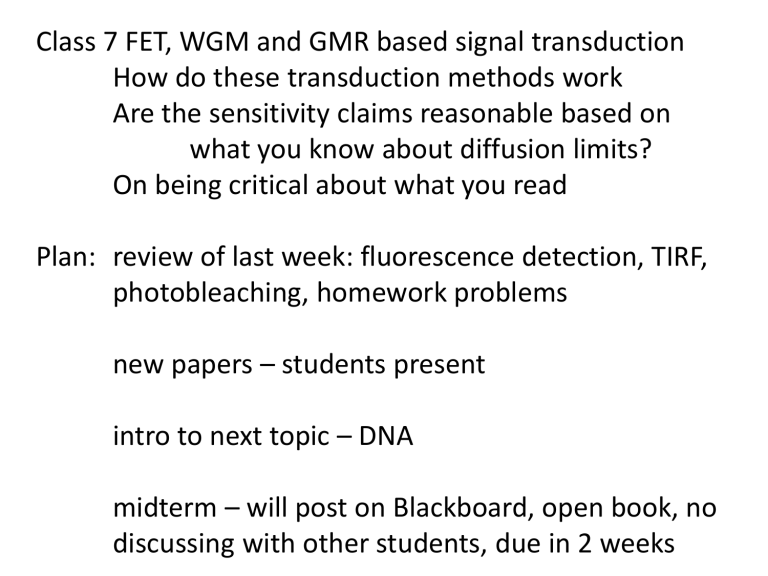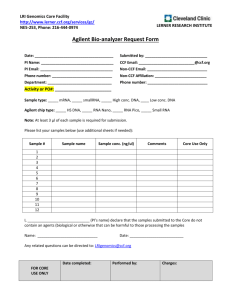Document

Class 7 FET, WGM and GMR based signal transduction
How do these transduction methods work
Are the sensitivity claims reasonable based on what you know about diffusion limits?
On being critical about what you read
Plan: review of last week: fluorescence detection, TIRF, photobleaching, homework problems new papers – students present intro to next topic – DNA midterm – will post on Blackboard, open book, no discussing with other students, due in 2 weeks
What is TIRF microscopy?
a
Evanescent field E falls off exponentially
~
E
0 penetration depth d < l e -z/d
Basically, a trick to reduce illumination where it doesn’t help (if ligand trapped on surface) -> reduce background
Model system to see captured protein
(Ab)
(sample)
His
Are dots single fluorescent molecules?
How could you tell?
5 m m
? monomer YFP
? dimer YFP life is not perfect
Model system to see captured protein
5 m m
(Ab)
(sample)
-His
If Ab conc is 30/ m m 2, how many
Ab’s in field of view?
What fraction have bound anal.?
If [YFP] is 100pM, what is K
D
?
What is minimum YFP conc. that would give a signal over bkgd?
Results - Model system to see captured protein
5 m m
(Ab)
(sample)
Would it help to look at multiple fields of view?
What could you try to do to improve sensitivity?
inc. Ab density, lower K
D
, reduce background (?photobleach
before adding sample)
Biosensor with transduction via FET on silicon nanorods
Used Ab-gold to estimate Ab density on NWs
Note these are mostly lower than usual max. est.
1/(10nm) 2 ? How would this affect capture rate?
Why do assay in low ionic strength buffer?
Why are pulses short in bottom trace?
Why are some pulses upward and some downward?
What rate of binding do you expect based on stated virus conc. 100/ m l, k on
10 6 /Ms, # Abs/rod?
What rate do you expect based on time to diffuse average distance between virus particles?
Conclusions – FET paper
FET seems to be detecting single viruses based on fluorescence, expected effect of charge
But claimed sensitivity too high
Did they take someone else’s word for virus concentration, perhaps measured in inf. particles/ml, and >100x more physical than infectious particles/ml?
FET will come back in DNA sequencing sensors
Whispering Gallery Mode (WGM) sensor – Armani et al.,
Label-free, single-molecule detection with optical
Microcavities. Science 317:783 (2007)
Claim sensitivity down to
~
10 -17 M
(~ 6 molecule/ m l)!
Lots of data points
Error bars
~
0.01pm (!)
What is K
D
? Does this make sense for Ab-ligand?
Could this be something else you know about?
Estimate # receptors on sensing part of torus
Area = p d p
D
~
1600 m m 2
Density < 1/100nm 2
So < 1.6x10
7
Estimate fraction of receptors bound
K
D
~
10 -9 M, if c free
< c
0
=10 -17 M, c free
<<K
D so [AbL]/Ab] < 10 -8
Are they detecting fewer than one molecule bound, on av.?
Expected binding rate at 100aM k on
*[ligand]*#Abs = 10 6 /Ms * 10 -16 M * 10 7 = 10 -3
Could local conc. be higher than bulk, k on
>> expected?
They say
Dl
>> expected based on IL2 mass, so they propose new mechanism based on protein absorbing light -> heat ->
D n
Max step size independent of conc.
(and diff. for diff. types of molecules) c/w single molecule binding events
Why might some (most) binding events give < max
Dl
?
Conclusions – WGM paper
Could they be sensing single molecules but have mis-stated ligand concentrations?
What would you want to ask them if you were a reviewer?
GMR transduction method paper
Sandwich immunoassay with superparamagnetic particle tags and GMR detection of magnetic labels
How many Abs/
1x100 m m x?20 strips?
Previous expt used 16nm magnetic beads on 200nm-wide sensors
Change in resistance was
~ number of beads stuck
Why is
DD
V
~
[c
0
] 1/3 in this experiment?
How do GMR sensor results differ from ELISA?
If K
D
= 10 -9 M, how many nanoparticles should be bound if free ligand is 5fM?
minutes
Time course of
DD
V What was exp’t? Why so fast?
Suppose conc. of beads is 4nM, K
D bond is 10 -15
In this case c
M, and k
0
/K
D simplifies to
~
1/(c
0
>>1 so t k on on is the usual 10 6 /Ms
) = rxn of biotin-SA
= (1/k off
)/(1+c
0
/K
D
)
Conclusions from WGM paper
WGM sensor nicely only sensitive to magnetic nanoparticles very close to surface (B
~
|m|/r 3 ,
I estimate B at particle radius < applied field used to magnetize particles), hence similar to
TIRF in not-seeing non-surface-bound labels
Don’t have to wash off labels, “real-time” only in this sense
Maybe sensitive to only a few stuck nanoparticles
Would be nice to know sensitivity as function of absolute number of bound nanoparticles
Not ‘real time’ in practical sense
Next 2 classes: DNA as nanoscale construction material
Constructs relying mainly on base pairing capture probes interwoven double helices – tubes, origami dynamic structures
Ways to take advantage of mechanical properties of DNA force vs extension relations use to study molecular motors that move on DNA
DNA amplification (pcr) for diagnostics, as tool to make things with DNA, amplification + selection -> in vitro evolution, aptamers, genes that encode novel proteins






